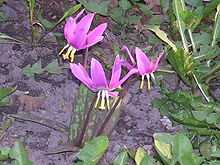Erythronium
| Erythronium | |
|---|---|
 | |
| Erythronium dens-canis (type species) | |
| Scientific classification | |
| Kingdom: | Plantae |
| (unranked): | Angiosperms |
| (unranked): | Monocots |
| Order: | Liliales |
| Family: | Liliaceae |
| Subfamily: | Lilioideae |
| Genus: | Erythronium |
| Species | |
|
See text. | |
Erythronium (fawn lily, trout lily, dog's-tooth violet, adder's tongue) is a genus of 20–30 species of hardy spring-flowering perennial plants with long, tooth-like bulbs. Slender stems carry pendent flowers with recurved tepals in shades of cream, yellow, pink and mauve. Species are native to forests and meadows in temperate regions of the Northern Hemisphere.[1]
Species
|
|
Uses
The bulb is edible as a root vegetable, cooked or dried, and can be ground into flour. The leaves can also be cooked as a leaf vegetable. In Japan, Erythronium japonicum is called katakuri, and the bulb is processed to produce starch, which is used for food and other purposes.
They are also widely grown as ornamental plants, with numerous hybrids and cultivars having been selected for garden use. Popular cultivars include Erythronium 'Pagoda', E. 'Sundisc', E. 'Joanna', E. 'Kondo', E. 'Citronella', E. californicum 'White Beauty', and E. 'Rosalind'. Propagation is best by seed in autumn or by division of bulbs, depending on species. Some species propagate vegetatively. The plant is also great as a ground cover, as it will spread over several years.
References
Gallery
-

Erythronium albidum
-
Erythronium americanum
-

Erythronium californicum
-

Erythronium citrinum
-
Erythronium dens-canis
-
Erythronium grandiflorum
-

Erythronium helenae
-

Erythronium hendersonii
-

Erythronium japonicum
-
Erythronium montanum
-
Erythronium oregonum
-

Erythronium propullans
-

Erythronium purpurascens
-

Erythronium purpurascens, end of blooming
-

Erythronium revolutum
-
Erythronium sibiricum
| Wikimedia Commons has media related to Erythronium. |
| ||||||||||||||||






.JPG)